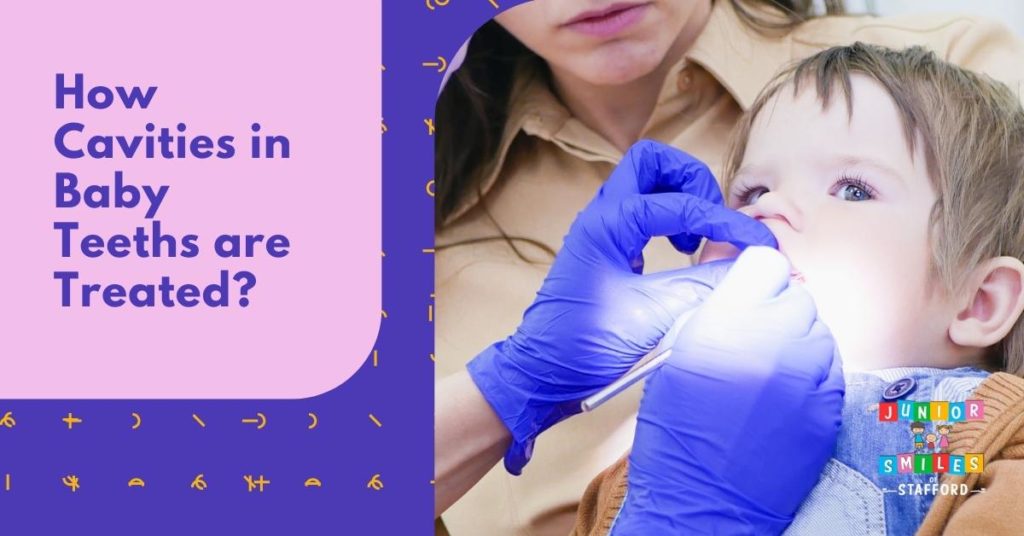How are Cavities in Baby Teeth Treated?

Tooth decay can begin with cavities, the most common type of disease in children. The best way to avoid cavities is to practice good oral hygiene at home, eat a healthy diet, and have regular dental exams and cleanings.
However, even with these efforts, cavities can still occur. A child’s teeth and the way they’re positioned in the mouth can make them more susceptible to cavities. Visiting the dentist regularly is essential because of this.
Early dental visits are critical to know more about how to treat cavities in baby teeth.
Causes of Cavities
Here are some reasons why children are at a higher risk for tooth decay than adults:
Baby teeth have thinner enamel
A baby tooth’s enamel layer is much thinner than that of a permanent tooth. Demineralization is the first step in the formation of any cavity. This is a weakening or softening of the enamel’s strong outer shell.
At this point, the process can be reversed, and no therapy is required on the tooth. Because the enamel on baby teeth is so thin, you have a considerably narrower window of opportunity to act and stop the decay process when demineralization begins.
There is a big difference between the rate of decay in infant’s teeth and the rate of decay in permanent teeth. To prevent your child’s teeth from being impacted, you will need to act promptly. Your child will not get better by sitting around and doing nothing. Cavities in baby teeth can quickly develop into serious oral infections if they are not treated.
Children have poor oral hygiene
As a result of a lack of oral hygiene skills, children are more prone to developing cavities. Unfortunately, children are incapable of brushing their teeth. Your child should not be brushing and flossing alone unless he can tie his shoes and write his name in cursive.
Plaque is left on teeth, even after brushing, because of poor oral hygiene. The bacteria in the plaque produce harmful and demineralizing acids.
This implies that even if your child brushes twice a day, they are still at risk of developing cavities.
Flossing is necessary for all teeth, including baby teeth. Ask us for some advice on how to properly floss your child’s teeth at your next appointment if you need some assistance with this task.
Read More: Bad Breath in Children: What You Need to Know
Children’s eating habits
One further thing to keep in mind is that children tend to eat more frequently than adults throughout the day. As a result, food can become trapped between teeth, resulting in tooth decay. On the other hand, sweet sweets have a detrimental effect on the health of baby teeth, especially if they are left unbrushed or flossed for too long.
Symptoms
The following factors most commonly cause tooth decay and cavities. However, each child’s decay is distinctive.
- In the affected locations, white patches start to appear on the teeth. The presence of these blemishes indicates that the enamel is beginning to erode. They may cause teeth to become sensitive at an early age.
- Symptoms of an early cavity can be seen on the tooth’s surface—light brown in hue.
- Sensitivities to cold meals and beverages
- Swollen mouth avoiding food
- Toothache and tenderness in the gums
The health of a child’s infant teeth cannot be overstated. When it comes to infant’s teeth, many parents think it’s unnecessary to repair cavities because their child would eventually lose these teeth.
A child’s dental health and entire well-being may suffer if cavities in their baby teeth are untreated. When decay is left untreated, children are at risk for experiencing extreme pain and illness and tooth loss and the development of gum disease, sleep deprivation, and an inability to eat.
As a result, the germs in a single decayed tooth can spread throughout a child’s mouth and into their permanent teeth. If left untreated, dental illness can have both short-term and long-term negative effects and impacts on a person’s health. This is especially true for children (and adults).
Treatment
A child’s symptoms, age, and overall health will be all factor into the treatment plan you develop for them. The severity of the illness will also play a role in how long it will take to recover. Dentists often recommend replacing teeth that have been damaged by decay with a filling. When teeth are damaged by tooth decay, fillings heal the damage.
Remineralization
If the cavity is small enough, the pediatric dentist may let the tooth heal naturally. This occurs because saliva can accelerate the healing process. Saliva contains proteins, enzymes, and chemicals that aid in the hardening of the enamel on teeth and can even “remineralize” them. A tooth can undergo remineralization (or self-repair) if a cavity is sufficiently tiny if oral hygiene and diet support saliva production.
White Fillings and Restoration
If remineralization doesn’t work, a filling will be needed to restore the teeth’ structure. Many adults and children are aware of this procedure. Your child’s pediatric dentist will remove the cavity and decay. The tooth will be treated with a filling after everything is removed.
Crowns
A filling will not be sufficient to restore a tooth with extensive decay or a huge cavity. A crown will be placed on top of the affected tooth to prevent further tooth decay and cavities. The tooth must first be shaved down before the prefabricated crown can be fitted to it, and the prefabricated crown is then glued to the tooth with dental cement.
Contact Junior Smiles of Stafford to know more about how to treat cavities in baby teeth.
Preventing tooth decay is possible. Contact a pediatric dentist if you notice signs of tooth decay or have any other concerns about your child’s dental health. Your child’s teeth can last a lifetime if they are cared for properly.
Read More: Alternatives to Filling Cavities in Babies
Why Choose Junior Smiles of Stafford?
Our Stafford, VA team is well-versed in working with clients of various ages and backgrounds. They’ll take the time to get to know you and your family’s requirements, and they’ll work with you to design a treatment plan that suits your schedule. Sealants and fluoride treatments are just two of the many preventative care options we provide to keep your mouth healthy.
About Us
Visiting Junior Smiles of Stafford means you’re in good hands when it comes to receiving high-quality care. Your child’s dental health improves with each visit, ensuring a brighter smile for years to come. We adhere to the ADA and AAPD’s guidelines for best practices.
Where Are We Located?
Phone: (540) 699-2441
Fax: (540) 699-2464
Email: info@juniorsmilesofstafford.com
Monday and Tuesday: 9:00 AM – 5:00 PM
Wednesdays and Thursdays: 8:00 AM – 4:00 PM
Fridays and Saturdays: 9:00 AM – 2:00 PM (By appointment only)
How to Book Your Kids First Appointment at Junior Smiles of Stafford
Fill out the form on our website. Within 24 hours, a member of our team will get back to you.

